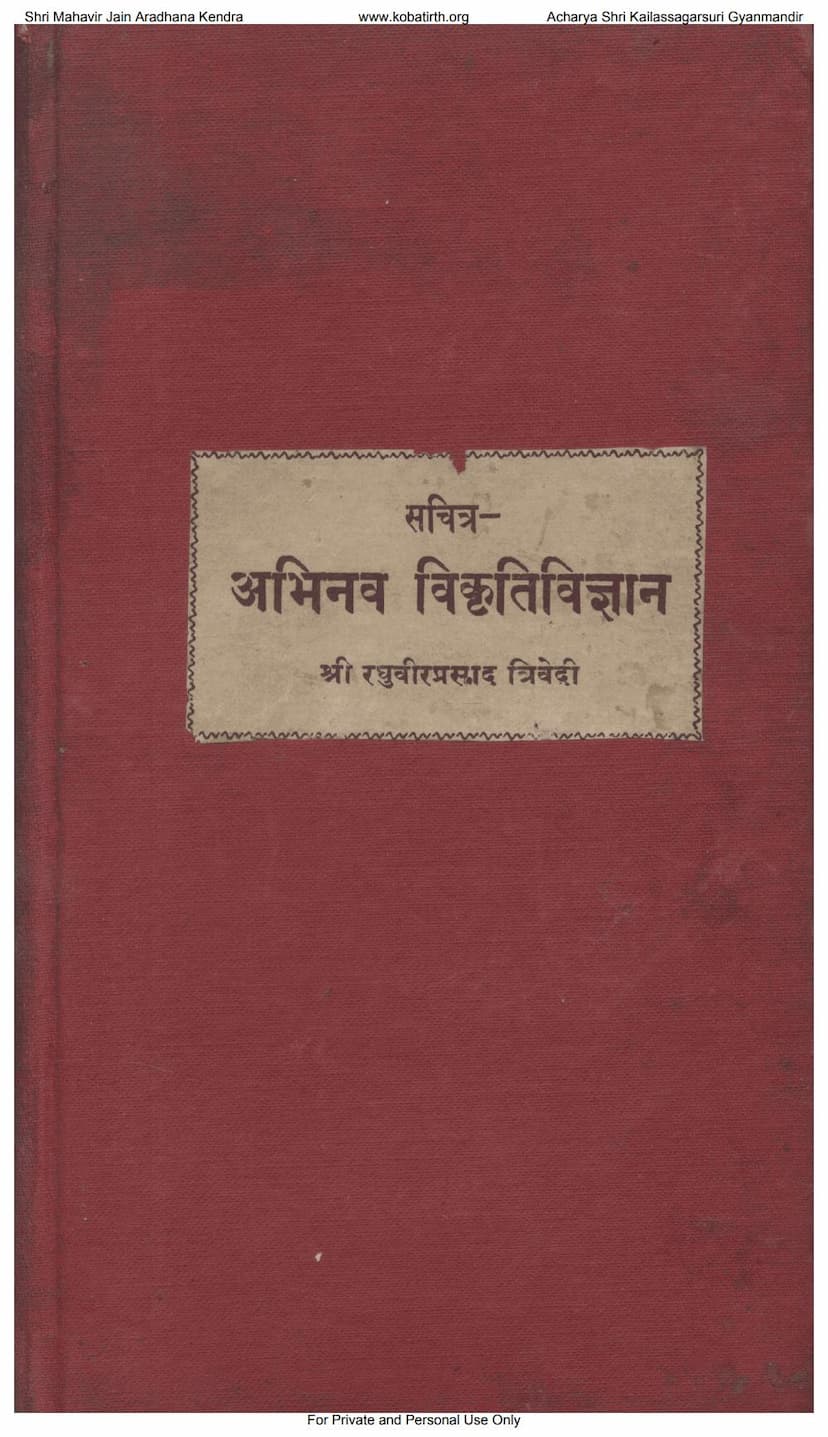Abhinav Vikruti Vigyan
Added to library: September 1, 2025

Summary
Here's a comprehensive summary of the Jain text "Abhinav Vikruti Vigyan" by Raghuveerprasad Trivedi, based on the provided pages:
Book Title: Abhinav Vikruti Vigyan (अभिनव विकृतिविज्ञान) Subtitle: A Text Book of Pathology - Ancient & Modern [A Text Book of Western and Ayurvedic Pathology] (पाश्चात्त्य तथा आयुर्वेदीय वैकारिकी का पाठ्यग्रन्थ) Author: Ayurvedacharya Pt. Raghuveerprasad Trivedi Publisher: Chaukhamba Vidyabhavan, Varanasi Publication Year: 1957 (Samvat 2013)
Overview:
"Abhinav Vikruti Vigyan" (New Pathology) is a seminal work by Ayurvedacharya Pt. Raghuveerprasad Trivedi, published by Chaukhamba Vidyabhavan in 1957. This textbook aims to bridge the gap between modern Western pathology and traditional Ayurvedic pathology (Vikriti Vigyan or Vaikariki). It was written during a crucial period when India was striving to develop its indigenous education systems post-independence, highlighting the urgent need for high-quality textbooks that integrated ancient knowledge with contemporary scientific understanding.
Key Themes and Contributions:
-
Integration of Ancient and Modern Knowledge: The book's primary objective is to present pathology from both the ancient Ayurvedic and modern Western perspectives. The author, highly respected in both fields, meticulously compares and contrasts concepts, aiming to provide a holistic understanding for Ayurvedic scholars and students. This approach is praised by the foreword and preface writers for its diligence, scholarship, and contribution to medical education.
-
Addressing the Need for Modern Ayurvedic Textbooks: The foreword by Dr. P.M. Mehta emphasizes the post-independence need for developing Ayurvedic educational institutions. He identifies the creation of good textbooks as a critical challenge. Trivedi's work is presented as a significant step in fulfilling this need, offering a comprehensive compilation that addresses subjects systematically, unlike the encyclopedic nature of ancient texts.
-
Pathology Explained from Ayurvedic Principles: The introduction by Dr. Bhaskar Govind Ghanekar highlights the importance of Vikriti Vigyan (Pathology) for physicians. He argues that a physician's true skill lies in accurate diagnosis, which is achieved through a deep understanding of pathological changes (Vikriti) and their etiological factors (Hetu). The text delves into the definition of Vikriti Vigyan, its causes (Hereditary, deficiency, infections, trauma, physical, chemical), and the process of disease manifestation (Samprapti). It discusses the evolution of pathology, from its limitations in ancient times due to the absence of post-mortem examinations to the advancements brought by techniques like microscopy and cellular pathology.
-
Comparative Analysis of Concepts: The book explicitly compares Ayurvedic and Western medical concepts related to pathology. For instance, it draws parallels between Ayurvedic classifications of disease causes and modern etiological factors. The author's preface by Dr. S.N. Khanna notes that the author has presented modern pathology with such skill that it appears seamlessly integrated with Ayurvedic pathology, making complex subjects accessible and engaging.
-
Detailed Exploration of Specific Pathologies: The extensive table of contents reveals the book's comprehensive coverage of various pathological conditions, discussed from both Ayurvedic and modern viewpoints. Key areas include:
- Inflammation (Vrana Shotha/Shotha): Detailed discussion on its definition, causes, symptoms (heat, redness, swelling, pain, loss of function), pathogenesis, and stages (Ama, Pachyamana, Pakva). It compares Ayurvedic concepts of Tridosha involvement in inflammation with modern understanding.
- Tissue Necrosis (Atimrityu/Utinash): Causes and types of tissue death.
- Degeneration (Vihraas): Various forms like fatty degeneration, mucoid degeneration, hyaline degeneration, and their manifestations in different organs.
- Disorders of Blood Circulation: Discussing conditions like anemia, thrombosis, embolism, etc.
- Repair (Punar-nirman): Processes of healing and tissue regeneration.
- Fever (Jvara): A vast section covering Ayurvedic classifications of fever based on doshic involvement, etiology, and timing, alongside modern perspectives.
- Specific Diseases: Tuberculosis, Syphilis, Granulomatous diseases, Tumors (Arbuda), and Blood Pathology are covered in detail, examining their pathological basis.
- Organ-Specific Pathology: Extensive chapters detail the effects of inflammation and other pathological processes on various organ systems:
- Bone and Joints
- Muscles and Tendons
- Heart
- Blood Vessels and Lymphatics
- Respiratory System
- Gastrointestinal Tract
- Liver and Gallbladder
- Kidneys and Urinary Tract
- Reproductive System (Male and Female)
- Nervous System (Brain, Spinal Cord)
- Gastrointestinal Tract (Stomatitis, Gingivitis, Glossitis, Gastritis, Enteritis, Appendicitis, Colitis)
- Urinary Tract (Cystitis, Urethritis)
- Reproductive System (Oophoritis, Salpingitis, Endometritis, Mastitis)
- Fever (Jvara)
-
Emphasis on Terminology and Clarity: The author acknowledges the challenge of finding appropriate Hindi terminology for scientific concepts. He has made efforts to use clear and descriptive Hindi equivalents, sometimes coining new terms based on Sanskrit grammar and meaning, while retaining Ayurvedic terms where appropriate. This dual approach aims to aid student comprehension.
-
Scholarly Apparatus: The book includes a foreword, introduction, and preface by eminent scholars in Ayurveda and modern medicine, lending it significant academic weight. It also features a comprehensive bibliography citing numerous national and international scholars whose works were consulted.
-
Dedication: The book is dedicated to respected Gurudevs like Dr. Mukund Swarup Verma and Dr. Bhaskar Govind Ghanekar, acknowledging their profound influence and contributions to Ayurvedic education.
Significance:
"Abhinav Vikruti Vigyan" is recognized as the first comprehensive textbook on pathology in the Hindi language that attempts to integrate Ayurvedic and modern concepts. It serves as a foundational text for Ayurvedic students and offers valuable comparative insights for modern medical students. The author's dedication to bridging these knowledge systems is evident throughout the work, making it a significant contribution to the field of medical education in India. The book acknowledges that while it provides a strong basis, future editions might incorporate further modifications and advancements as the field evolves.